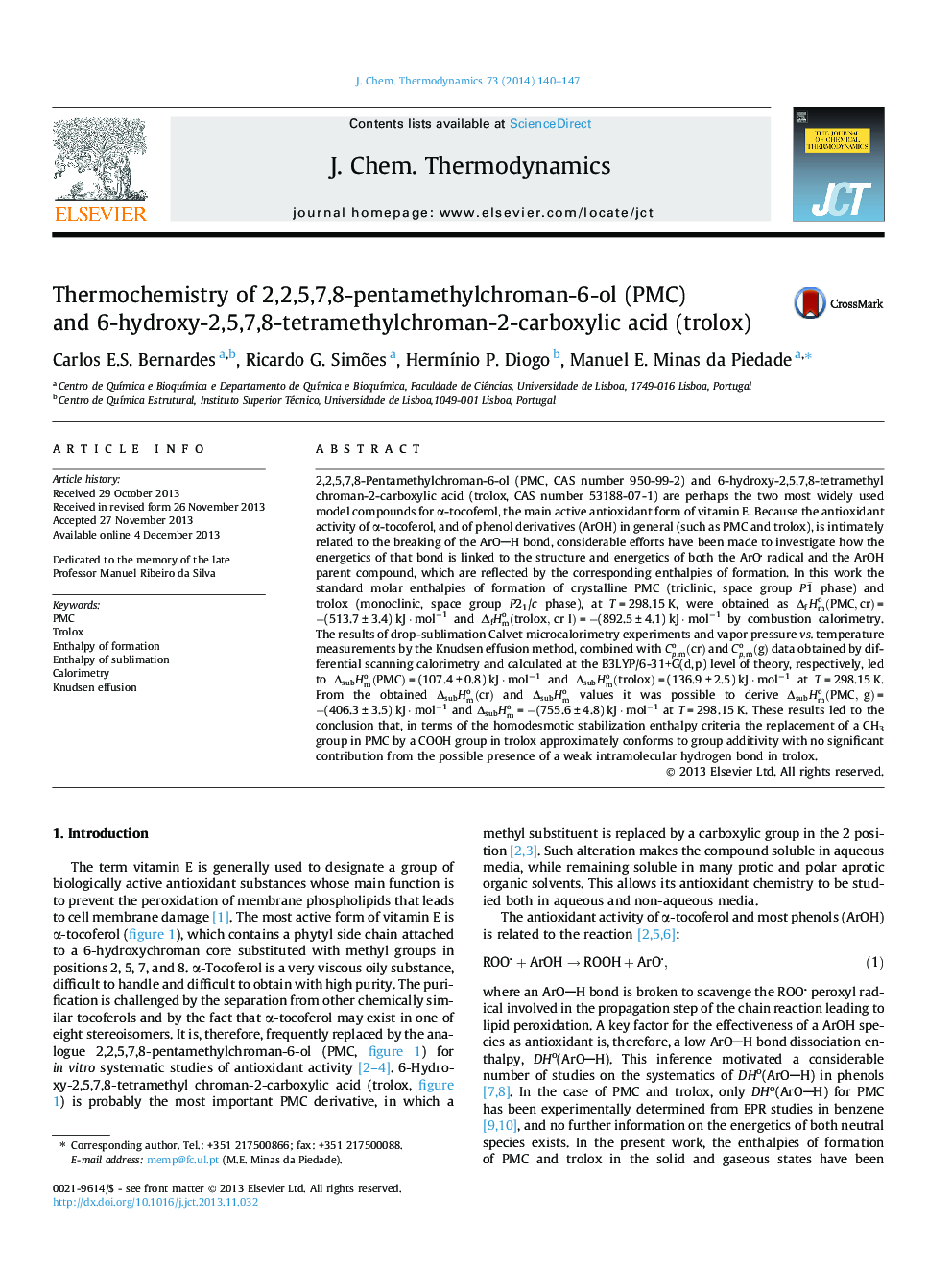| کد مقاله | کد نشریه | سال انتشار | مقاله انگلیسی | نسخه تمام متن |
|---|---|---|---|---|
| 215482 | 1426240 | 2014 | 8 صفحه PDF | دانلود رایگان |

• We measured Cp,mo(cr/g), ΔfHmo(cr/g), ΔfusHmo and ΔsubHmo for 2,2,5,7,8-pentamethylchroman-6-ol (PMC).
• We measured Cp,mo(cr/g), ΔfHmo(cr/g), ΔfusHmo and ΔsubHmo for 6-hydroxy-2,5,7,8-tetramethylchroman-2-carboxylic acid (trolox).
• We found that, if present, an intramolecular hydrogen bond in trolox must be weak.
• We found that the replacement of a CH3 group in PMC by a COOH group in trolox approximately conforms to group additivity.
2,2,5,7,8-Pentamethylchroman-6-ol (PMC, CAS number 950-99-2) and 6-hydroxy-2,5,7,8-tetramethyl chroman-2-carboxylic acid (trolox, CAS number 53188-07-1) are perhaps the two most widely used model compounds for α-tocoferol, the main active antioxidant form of vitamin E. Because the antioxidant activity of α-tocoferol, and of phenol derivatives (ArOH) in general (such as PMC and trolox), is intimately related to the breaking of the ArOH bond, considerable efforts have been made to investigate how the energetics of that bond is linked to the structure and energetics of both the ArO radical and the ArOH parent compound, which are reflected by the corresponding enthalpies of formation. In this work the standard molar enthalpies of formation of crystalline PMC (triclinic, space group P1¯ phase) and trolox (monoclinic, space group P21/c phase), at T = 298.15 K, were obtained as ΔfHmo(PMC,cr) = −(513.7 ± 3.4) kJ · mol−1 and ΔfHmo(trolox,crI) = −(892.5 ± 4.1) kJ · mol−1 by combustion calorimetry. The results of drop-sublimation Calvet microcalorimetry experiments and vapor pressure vs. temperature measurements by the Knudsen effusion method, combined with Cp,mo(cr) and Cp,mo(g) data obtained by differential scanning calorimetry and calculated at the B3LYP/6-31+G(d, p) level of theory, respectively, led to ΔsubHmo(PMC) = (107.4 ± 0.8) kJ · mol−1 and ΔsubHmo(trolox) = (136.9 ± 2.5) kJ · mol−1 at T = 298.15 K. From the obtained ΔsubHmo(cr) and ΔsubHmo values it was possible to derive ΔsubHmo(PMC, g) = −(406.3 ± 3.5) kJ · mol−1 and ΔsubHmo = −(755.6 ± 4.8) kJ · mol−1 at T = 298.15 K. These results led to the conclusion that, in terms of the homodesmotic stabilization enthalpy criteria the replacement of a CH3 group in PMC by a COOH group in trolox approximately conforms to group additivity with no significant contribution from the possible presence of a weak intramolecular hydrogen bond in trolox.
Figure optionsDownload as PowerPoint slide
Journal: The Journal of Chemical Thermodynamics - Volume 73, June 2014, Pages 140–147